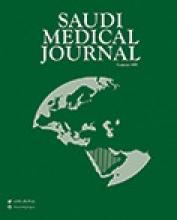Abstract
OBJECTIVE: Venous thromboembolism (VTE) is a common disorder associated with significant mortality and morbidity. Considerable progress has been made in the understanding of the risk factors. Significant portion of patients develop VTE without obvious risk factors. The clinical applications of molecular techniques allowed identification of many important inherited, yet not uncommon risk factors. The aim of our study was to determine whether the activated protein C resistance (APCR)/Factor V Leiden (FVL), and prothrombin mutation as being the most common inherited risk factor for venous thrombosis among Saudi patients attending an anticoagulant clinic.
METHODS: One hundred and seventy-nine consecutive patients (74 males, 105 females) accrued in a prospective study with a median age of 42 years (range 17-60 years) have been screened between October 1997 and January 2002 at the King Abdul-Aziz University Hospital (KAUH) and King Fahd Armed Forces Hospital (KFAFH), Jeddah, Kingdom of Saudi Arabia. All patients were Saudis with at least one of the following features: history of recurrent VTE, first episode of unprovoked VTE, thrombosis in unusual site or thrombosis at young age with or without positive family history. Thrombotic workup included protein C, protein S, antithrombin (AT), APCR, prothrombin mutation, lupus anticoagulant (LA), and anticardiolipin (ACL). Functional assays were carried out in 179 patients. Molecular analysis of both FVL, prothrombin G29210A mutation was performed in 67 patients. All tests were carried out in reference laboratories (Mayo Clinic, United States of America and Bioscientia, Germany).
RESULTS: Protein S deficiency was the most common, identified in 26/179 (14.5%) followed by protein C in 15/179 (8.4%), while AT was not deficient in all 179 tested patients. Activated protein C resistance was present in only 4 patients (2.2%). Two patients were tested positive for prothrombin mutation; one of them was heterozygous for FVL too. Eight percent of the patients had LA, while 4% had ACL antibodies.
CONCLUSION: Our study shows a different distribution pattern of the underlying thrombophilic state than reported in the western literature. If this holds true in larger trials, this may result in changing our local screening and diagnostic workup in patients with suspected hypercoagulable state.
- Copyright: © Saudi Medical Journal
This is an open-access article distributed under the terms of the Creative Commons Attribution-Noncommercial-Share Alike 3.0 Unported, which permits unrestricted use, distribution, and reproduction in any medium, provided the original work is properly cited.






